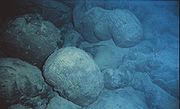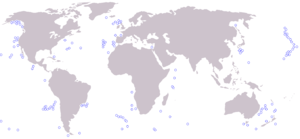
Submarine volcano
Encyclopedia





Volcano
2. Bedrock3. Conduit 4. Base5. Sill6. Dike7. Layers of ash emitted by the volcano8. Flank| 9. Layers of lava emitted by the volcano10. Throat11. Parasitic cone12. Lava flow13. Vent14. Crater15...
es are underwater fissures in the Earth
Earth
Earth is the third planet from the Sun, and the densest and fifth-largest of the eight planets in the Solar System. It is also the largest of the Solar System's four terrestrial planets...
's surface from which magma
Magma
Magma is a mixture of molten rock, volatiles and solids that is found beneath the surface of the Earth, and is expected to exist on other terrestrial planets. Besides molten rock, magma may also contain suspended crystals and dissolved gas and sometimes also gas bubbles. Magma often collects in...
can erupt. They are estimated to account for 75% of annual magma output. The vast majority are located near areas of tectonic plate movement, known as ocean ridges. Although most are located in the depths of sea
Sea
A sea generally refers to a large body of salt water, but the term is used in other contexts as well. Most commonly, it means a large expanse of saline water connected with an ocean, and is commonly used as a synonym for ocean...
s and ocean
Ocean
An ocean is a major body of saline water, and a principal component of the hydrosphere. Approximately 71% of the Earth's surface is covered by ocean, a continuous body of water that is customarily divided into several principal oceans and smaller seas.More than half of this area is over 3,000...
s, some also exist in shallow water, which can spew material into the air during an eruption. Hydrothermal vent
Hydrothermal vent
A hydrothermal vent is a fissure in a planet's surface from which geothermally heated water issues. Hydrothermal vents are commonly found near volcanically active places, areas where tectonic plates are moving apart, ocean basins, and hotspots. Hydrothermal vents exist because the earth is both...
s, sites of abundant biological activity, are commonly found near submarine volcanoes.
The presence of water can greatly alter the characteristics of a volcanic eruption and the explosions made by these. For instance, the increased thermal conductivity of water causes magma to cool and solidify much more quickly than in a terrestrial eruption, often turning it into a volcanic glass
Volcanic glass
Volcanic glass is the amorphous product of rapidly cooling magma. Like all types of glass, it is a state of matter intermediate between the close-packed, highly ordered array of a crystal and the highly disordered array of gas...
. Below ocean depths of about 2200 metres where the pressure exceeds 218 atmospheres, the critical pressure of water, it can no longer boil; it becomes a supercritical fluid
Supercritical fluid
A supercritical fluid is any substance at a temperature and pressure above its critical point, where distinct liquid and gas phases do not exist. It can effuse through solids like a gas, and dissolve materials like a liquid...
. Without boiling sounds, deep-sea volcanoes are difficult to detect at great distances using hydrophones.
The lava formed by submarine volcanoes is quite different from terrestrial lava. Upon contact with water, a solid crust forms around the lava. Advancing lava flows into this crust, forming what is known as pillow lava
Pillow lava
Pillow lavas are lavas that contain characteristic pillow-shaped structures that are attributed to the extrusion of the lava under water, or subaqueous extrusion. Pillow lavas in volcanic rock are characterized by thick sequences of discontinuous pillow-shaped masses, commonly up to one metre in...
.
Scientists still have much to learn about the location and activity of underwater volcanoes. The Kolumbo underwater volcano in the Aegean Sea was discovered in 1650 when it burst from the sea and erupted, killing 70 people on the nearby island of Santorini
Santorini
Santorini , officially Thira , is an island located in the southern Aegean Sea, about southeast from Greece's mainland. It is the largest island of a small, circular archipelago which bears the same name and is the remnant of a volcanic caldera...
. More recently, NOAA's Office of Ocean Exploration
Office of Ocean Exploration
In the United States the Office of Ocean Exploration is a division of the National Oceanic and Atmospheric Administration run under the auspices of the Office of Oceanic and Atmospheric Research ....
has funded missions to explore submarine volcanoes. Most notably, these have been the Ring of Fire missions to the Mariana Arc in the Pacific Ocean. Using Remote Operated Vehicles, scientists studied underwater eruptions, ponds of molten sulfur
Sulfur
Sulfur or sulphur is the chemical element with atomic number 16. In the periodic table it is represented by the symbol S. It is an abundant, multivalent non-metal. Under normal conditions, sulfur atoms form cyclic octatomic molecules with chemical formula S8. Elemental sulfur is a bright yellow...
, black smoker chimneys and even marine life adapted to this deep, hot environment.
Many submarine volcanoes are usually found as seamount
Seamount
A seamount is a mountain rising from the ocean seafloor that does not reach to the water's surface , and thus is not an island. These are typically formed from extinct volcanoes, that rise abruptly and are usually found rising from a seafloor of depth. They are defined by oceanographers as...
s. These are typically formed from extinct volcanoes, that rise abruptly and are usually found rising from a seafloor of 1,000 - 4,000 metres depth. They are defined by oceanographers
Oceanography
Oceanography , also called oceanology or marine science, is the branch of Earth science that studies the ocean...
as independent features that rise to at least 1,000 metres above the seafloor. The peaks are often found hundreds to thousands of metres below the surface, and are therefore considered to be within the deep sea
Deep sea
The deep sea, or deep layer, is the lowest layer in the ocean, existing below the thermocline and above the seabed, at a depth of 1000 fathoms or more. Little or no light penetrates this part of the ocean and most of the organisms that live there rely for subsistence on falling organic matter...
. An estimated 30,000 seamounts occur across the globe, with only a few having been studied. However, some seamounts are also unusual. For example, while the summits of seamounts are normally hundreds of metres below sea level, the Bowie Seamount
Bowie Seamount
Bowie Seamount is a large submarine volcano in the northeastern Pacific Ocean, located west of Haida Gwaii, British Columbia, Canada.The seamount is named after William Bowie of the Coast & Geodetic Survey....
in Canada's Pacific waters rises from a depth of about 3,000 metres to within 24 metres of the sea surface.
External links
- Volcano Information from the Deep Ocean Exploration Institute, Woods Hole Oceanographic InstitutionWoods Hole Oceanographic InstitutionThe Woods Hole Oceanographic Institution is a private, nonprofit research and higher education facility dedicated to the study of all aspects of marine science and engineering and to the education of marine researchers. Established in 1930, it is the largest independent oceanographic research...
- Volcano World - now maintained by the Department of Geosciences at Oregon State University
- Britannica - Submarine Volcanoes
- United States Geological Survey
- Ring of Fire Exploration Mission

